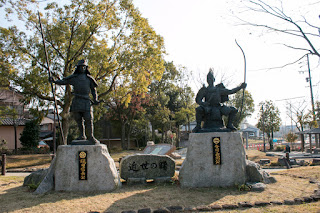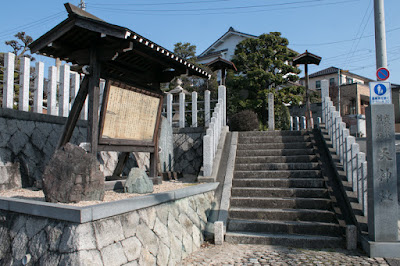Castles relate battle of Okehazama (1)
-Before the clash of two warlords-
Brief History
Okehazama is a hilly area spread at the southeast edge of Nagoya city and Toyoake city of Aichi prefecture. This area is a part of hills continues from east part of Nagoya city to Chita peninsula, and crossing point of Tokaido road, a historical trunk line connected Kyoto city and Kanto region on these hills.
Due to this location, Okehazama area became the target of struggle of Nobunaga Oda and Yoshimoto Imagawa, and finally in 1560 Nobunaga defeated Yoshimoto at the battle of Okehazama (桶狭間の戦い) and got a foothold to leap to the central ruler in 20 years. During the continuous battle at this area many castles and forts were used, then introduce related castles along with the process of the battle.
 |
| Situation of Oda clan and Imagawa clan just before the battle of Okehazama (Blue: Oda side castles, Red: Imagawa side castles) |
Growth of Nobuhide Oda
Nobunaga Oda (1534-1582), one participant of the battle, was the son of Nobuhide Oda (1510-1551) who was the lord at Shohata castle at the western part of Owari province (western part of Aichi prefecture). In Muromachi era, Shiba clan which was the relative of Muromachi Shogunate was appointed as the governor of the country, along with Totomi province (western part of Shizuoka prefecture) or Echizen province (Fukui prefecture).
Shiba clan appointed Oda clan as a deputy governor of Owari province, and also placed Asakura clan which was later extinguished by Nobunaga Oda also as a deputy governor of Echizen country. But by the end of 16th century, Shiba clan lost Echizen country by uprising of Asakura clan and Totomi country by invasion of Imagawa clan, then only kept Owari country but their existence became nominal.
Oda clan which seized the authority at Owari province divided into two families, it mean Iwakura Oda clan at Iwakura castle had upper area such as Inuyama or Iwakura area, and Kiyosu Oda clan at Kiyosu castle held lower area such as Kiyosu area or Tsushima area. House of Nobuhide was originally one of the three chief retainers for Kiyosu Oda clan, but Nobuhide seized economic interests of Tsushima port (current Tsushima city and formerly faced Kiso river and Ise gulf) prospered at Medieval era.
Based on his wealth, Nobuhide gradually lead other houses of Oda clan and aimed at external expansion. Nobuhide could not beat upper Shiba clan or other Oda houses, thus aimed at eastward then captured Nagoya castle, Furuwatari castle or Suemori castle at the center of current Nagoya city. Nobuhide reached to the east border of Owari clan, and next aimed at Mikawa country (eastern part of Aichi prefecture).
Transform of Imagawa clan
Imagawa clan, other participant of the battle, was also a close relative of Muromachi Shogunate, and a distinguished family which could be the spare of Shigunate if main stream of Ashikaga clan was extinguished. Imagawa clan activated at the establishment of Muromachi Shogunate, and Sadayo Imagawa (1326-1420) once subjugated Kyushu island which was kept by Emperor Godaigo said lord and became the governors of Suguga province (middle part of Shizuoka prefecture), Totomi country and whole Kyushu island. Later Imagawa clan lost the governor of Totomi country and Kyushu island, but inheried the one of Suruga country.
At the end of 15th century, Ujichika Imagawa (1471-1526) won an internal conflict named “Osika no Ran” under the support of his uncle Moritoki Ise (1432-1519, later Soun Hojyo) and succeeded the clan. Ujichika established their own law “Imagawa Kana Mokuroku”, and transferred Imagawa clan into a centralized warlord. Ujichika continued fighting against Totomi country, and finally seized whole Totomi province before his death. Ujichika also married with Jyukeini (?-1568), even though a daughter of noble who later struggled the continuation of Imawara clan at crisis.
After the death of Ujichika, another internal conflict named as “Hanagura no Ran” occurred. Yoshimoto Imagawa (1519-1560) survived this conflict under the support of his monk chancellor Taigen Soufu Sessai (1496-1555), and finally seized the leader position. Yoshimoto revised Imawara Kana Mokuroku, and introduced the system of Yorioya Yoriko, which was to attach warrierrs or lords to large retainers.
This system enables mobilize of large number soldiers, and military basis of Imagawa clan significantly strengthened. As eastward of Imagawa clan was Hojo clan, another strong warlord, Yoshimoto seek expansion for westward. Totomi country was already captured and next country at westward was Mikawa province.
Conflict of two warlords for Mikawa country
Since 15th century there had been no strong authority in Mikawa country. But Matsudaira clan which was originally a small local lord at north part of current Toyota city, gradually expanded their power. In 1523, a brilliant leader Kiyoyasu Matsudaira (1511-1535) succeeded the leader position, and once united whole Mikawa province in only six years.
Ujichika Imagawa abandoned to the invasion to Mikawa province, and Kiyoyasu assaulted Owari country and captured Moriyama castle. But probably due to the plot of Nobuhide Oda, Kiyoyasu was assassinated at Moriyama castle and the power of Matsudaira clan rapidly declined.
Utilizing this opportunity, Nobuhide advanced to Mikawa province and captured Anjyo castle, a major base at western part of Mikawa province in 1540. Further Nobuhide defeated alliance of Matsudaira clan and Imagawa clan at the first battle of Azukizaka in 1542, then strengthened their dominance at Mikawa province.
Facing this situation Hirotada Matsudaira (1526-1549), son of Kiyoyasu and leader of the clan, asked assistance to Yoshimoto and sent his son Takechiyo Matsudaira (1543-1616, later Ieyasu Tokugawa) and Imagawa clan. But becauce of the plot of Nobuhide, Takechiyo was seized by Nobuhide and sent to Owari country. Nobuhide once seemed to capture Mikawa country.
But in 1547, Nobuhide attacked Dosan Saito (1494-1556), an upstart governor of Mino country (Gifu prefecture) and suffered a severe defeat. On this situation Yoshimoto and Sessai restarted their attack to Oda army at Mikawa country, and defeated Oda army at the second battle of Azukizaka in 1548.
Sessai also fell Anjyo castle guarded by Nobuhiro Oda (?-1574) and captured him, then exchanged Nobuhiro to Takechiyo. Takechiyo was kept at Sunpu city, the capital of Imawara clan, and next year Hirotada was assassinated same as his father. Now Imagawa clan virtually dominated Matsudaira clan and held Mikawa province. Depressed Nobuhide died in 1551, and his son Nobunaga Oda (1534-1582) succeeded the leader position of Oda clan.
Succession and struggle of Nobunaga Oda
As Nobuhide could not dominate but only gathered other Oda lords, Nobunaga became isolated at his succession. In 1552, Noritsugu Yamaguchi who was the commander of Narumi castle, an important castle at southwest border of the country, changed to Imagawa side. Nobumaga promptly fought with Noritsugu at Akatsuka near the Narumi castle.
Nobunaga fought well but could not beat Noritsugu, thus Narumi area became the territory of Imagawa clan. Further in 1554 Imagawa clan sent their army to Muraki fort (Higashiura town) to suppress Mizuno clan, an ally of Nobunaga. This time Nobunaga quickly lead his army and attacked the fort, and finally captured.
As above Nobunga barely rejected the pressure of Yoshimoto, but in 1554 an triangle treaty between Imagawa clan, Takeda clan which was the warlord of Kai country (Yamanashi prefecture) and Hojyo clan. Now the backside of Imagawa clan was stabilized and now Yoshimoto could concentrate on the expansion for westward.
It took several years to suppress non obedient local lords at Mikawa province, but by 1560 Mikawa province was totally captured by Imagawa clan, and Yoshimoto now ready to assault Nobunaga. Noritsugu Yamaguchi captured Odaka castle and Kutsukake castle from Oda clan, but later was purged by Yoshimoto. Yoshimoto placed his important generals such as Nagateru Udono (?-1562) or Motomobu Okabe (?-1581) as vanguard against Nobunaga.
On the other hand, Nobunaga was in tough situation but gradually expand his power. In 1554, when Kiyosu Oda clan revolted Shiba clan which was nominal governor of Owari province, Nobunaga defeated Kiyosu Oda clan and captured Kiyosu castle.
In 1556, his younger brother Nobukatsu Oda (1536-1557, known as Nobuyuki) revolted to Nobunaga with important retainers of Nobunaga such as Hidesada Hayashi (?-1580) or Katsuie Shibata (1522-1582), but Nobunaga defeated them at the battle of Ano, and finally killed Nobukatsu. Finally in 1559, Nobunaga defeated Iwakura Oda clan and captured Iwakura castle, then Nobunaga barely could unite Owari province just before the invasion of Yoshimoto.
Encirclement of two castles
To confine the activity of Imagawa army at Narumi castle and Odaka castle, Nobunaga built fort around both castles. Tange fort, Zenshoji fort and Nakajima fort surrounds Narumi castle, and Wasizu fort, Marune fort, Hikami fort and Shokoji fort watched Odaka castle. These forts were built utilizing the edge of the hill, to spare construction cost and defend by small troops.
It is said that Imagawa clan placed 1,000 soldiers for both of Narumi and Odaka castles, and Oda clan sent 500 soldiers for each fort. But seeing the size of these castles, it seems Imagawa soldiers were 500 for both castle, and Oda clan placed 100 or 200 soldiers for each fort.
In May 1560, Yoshimoto Imagawa finally organized large army insisting 30,000 soldiers (actually might be 15,000 to 20,000) and marched to Owari country. Formerlly the aim of this excursion was to march to Kyoto city, the capital, and establish new government. But even though a distinguish lord under Muromachi Shogunate, Yoshimoto did not have any candidate of Shogun, different from Miyoshi clan or Nobunaga later established their own government at Kyoto.
Further, Yoshimoto did not announce his intention and gather the supporting powers, which was necessary to establish new government distant from his nation. Due to such reasons, today the purpose of this march was to release the encirclement of Oda army to both castles, and if possible let Nobunaga yield to Yoshimoto.
Anyway after one week march, Yoshimoto arrived at Kutsukake castle, a base of Imagawa clan at the border of Mikawa province and Owari province. The time for the decisive battle for both warlords has approached.
 |
| Detailed map of Okehazama area (Blue: Oda side, Red: Imagawa side) just before battle of Okehazama |
Note: Above maps were generated from the map of Geographical Survey Institution.
http://portal.cyberjapan.jp/site/mapuse4/
Continue to Part 2
Related Castles
Pictures (click to enlarge)
Imagawa side castles
Narumi Castle
Narumi castle (鳴海城) is located at the north of Narumi station. It was a hill castle of 200 meter long and 50 meter width, and castle site becomes park and shrine.
Odaka Castle
Odaka castle (大高城) is located at the south of Odaka station. It is a hill castle spread over 200 meter long square, and preserves the shape of each area well.
Kutsukake Castle
Kutsukake Castle (沓掛城) is located near the city office of Toyoake city. It is a plain castle among the rice field, and clay walls of the castle still remain.

























No comments:
Post a Comment